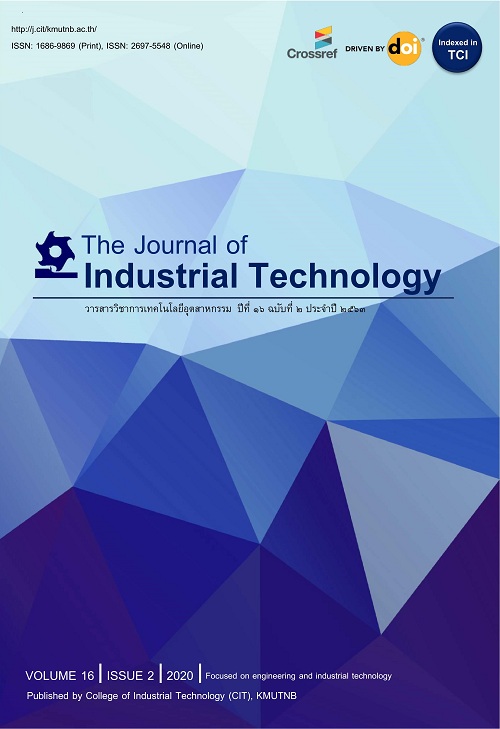การประยุกต์ใช้เทคนิค Hybrid DEA-TOPSIS สำหรับการคัดเลือกวัสดุชีวมวลที่เหมาะสมสำหรับการแปรรูปเป็นแท่งเชื้อเพลิง
Using the Hybrid DEA-TOPSIS Technique for Selecting the Suitable Biomass Materials for Processing into Fuel Briquettes
Abstract
บทคัดย่อ
กระบวนการตัดสินใจในการเลือกวัสดุชีวมวลที่เหมาะสมจากวัสดุทางการเกษตรเพื่อนำมาแปรรูปเป็นเชื้อเพลิงอัดแท่งเป็นปัญหาที่มีความซับซ้อนยากต่อการตัดสินใจเพราะว่ามีปัจจัยหรือคุณสมบัติที่เกี่ยวข้องหลายอย่างที่ต้องพิจารณาไปพร้อม ๆ กัน ดังนั้นงานวิจัยนี้จึงได้นำเสนอเทคนิค TOPSIS DEA และ hybrid DEA-TOPSIS ในการประเมินและจัดลำดับความสำคัญของวัสดุชีวมวลแต่ละชนิด เริ่มจากการกำหนดคุณสมบัติที่สำคัญของเชื้อเพลิงอัดแท่ง ซึ่งคุณสมบัติเหล่านี้จะถูกกำหนดให้เป็นตัวแปรนำเข้าและตัวแปรผลผลิตในเทคนิค DEA (เป็นปัจจัยหรือเกณฑ์สำหรับเทคนิค TOPSIS) ส่วนชนิดของถ่านอัดแท่งจากวัสดุทางการเกษตรจะถูกกำหนดให้เป็นหน่วยผลิตสำหรับเทคนิค DEA (เป็นทางเลือกสำหรับเทคนิค TOPSIS) หลังจากนั้นเทคนิค TOPSIS DEA และ hybrid DEA-TOPSIS ได้ถูกนำมาใช้สำหรับการประเมินและจัดลำดับความสำคัญของวัสดุชีวมวลแต่ละชนิด โดยในกรณีศึกษาที่ 1 มีจำนวนทางเลือก 23 ทางเลือก และมีปัจจัยที่เกี่ยวข้องจำนวน 5 ปัจจัย ได้แก่ ความชื้น เถ้า สารระเหย คาร์บอนคงตัว และค่าความร้อน ผลการทดสอบสัมประสิทธิ์สหสัมพันธ์สเปียร์แมนระหว่างเทคนิค hybrid DEA-TOPSIS กับเทคนิค DEA และ TOPSIS มีค่าเท่ากับ 0.863 และ 0.932 ตามลำดับ สำหรับกรณีศึกษาที่ 2 มีจำนวนทางเลือก 7 ทางเลือก และมีปัจจัยที่เกี่ยวข้องจำนวน 3 ปัจจัย ได้แก่ ค่าความร้อน คาร์บอนคงตัว และความชื้น ผลการทดสอบสัมประสิทธิ์สหสัมพันธ์สเปียร์แมนระหว่างเทคนิค hybrid DEA-TOPSIS กับเทคนิค DEA และ TOPSIS มีค่าเท่ากับ 1 เท่ากันดังนั้นวิธีที่นำเสนอในงานวิจัยนี้สามารถเป็นแนวทางในการเลือกวัสดุชีวมวลที่เหมาะสมจากวัสดุทางการเกษตรสำหรับการนำมาแปรรูปเป็นเชื้อเพลิงอัดแท่งได้
Abstract
The decision-making process for selecting the suitable biomass materials from agricultural materials for processing into fuel briquettes is a complex problem, which is difficult to decide because it has several properties/factors to consider simultaneously. In this paper, the TOPSIS, DEA and hybrid DEA-TOPSIS techniques have been proposed for evaluating and ranking the suitable biomass materials from agricultural materials. Firstly, the relevant properties of biomass materials for processing into fuel briquettes were determined. The properties of each biomass material from the agricultural materials were viewed as input and output variables for DEA (as factors for TOPSIS) and the alternatives of the biomass materials from agricultural materials were viewed as decision making units for DEA (as alternatives for TOPSIS). After that, using TOPSIS, DEA and the hybrid DEA-TOPSIS techniques were used to evaluate and rank the biomass materials from agricultural materials. In the case study 1, there are 23 alternatives and 5 relevant criteria, including the moisture content, ash, volatile matters, fixed carbon and heating value. The results of the Spearman correlation coefficient test between the hybrid DEA-TOPSIS technique and DEA and TOPSIS techniques were 0.863 and 0.932, respectively. For the case study 2, there are 7 alternatives and 3 relevant criteria, including the heating value, fixed carbon and moisture content. The results of the Spearman correlation coefficient test between the hybrid DEA-TOPSIS technique and DEA and TOPSIS techniques were same value (Correlation coefficients are equal to 1). For these reasons, the proposed techniques can lead to selecting suitable biomass materials for processing into fuel briquettes by considering several relevant criteria.
Keywords
Refbacks
- There are currently no refbacks.






